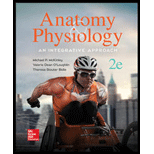
Anatomy & Physiology: An Integrative Approach
2nd Edition
ISBN: 9780078024283
Author: Michael McKinley Dr., Valerie O'Loughlin, Theresa Bidle
Publisher: McGraw-Hill Education
expand_more
expand_more
format_list_bulleted
Question
Chapter 14, Problem 17DYKB
Summary Introduction
To describe:
The muscles which are innervated by tibial and common fibular nerves.
Concept introduction:
Tibial nerves are formed from anterior divisions of the sciatic nerve. The sciatic nerve is the longest nerve in the body. Fibular nerves are formed from the posterior division of sciatic nerve.
Expert Solution & Answer
Want to see the full answer?
Check out a sample textbook solution
Students have asked these similar questions
What is the structure and function of Eukaryotic cells, including their organelles? How are Eukaryotic cells different than Prokaryotic cells, in terms of evolution which form of the cell might have came first? How do Eukaryotic cells become malignant (cancerous)?
What are the roles of DNA and proteins inside of the cell? What are the building blocks or molecular components of the DNA and proteins? How are proteins produced within the cell? What connection is there between DNA, proteins, and the cell cycle? What is the relationship between DNA, proteins, and Cancer?
Why cells go through various types of cell division and how eukaryotic cells control cell growth through the cell cycle control system?
Chapter 14 Solutions
Anatomy & Physiology: An Integrative Approach
Ch. 14.1 - Prob. 1WDYLCh. 14.1 - Prob. 2WDYLCh. 14.2 - Prob. 3WDYLCh. 14.3 - Prob. 4WDYLCh. 14.3 - Prob. 5WDYLCh. 14.4 - Prob. 6WDYLCh. 14.4 - What are the general locations and functions of...Ch. 14.4 - What type of information does the posterior...Ch. 14.4 - Prob. 9WDYLCh. 14.4 - Prob. 10WDYL
Ch. 14.4 - Prob. 11WDYLCh. 14.5 - Prob. 12WDYLCh. 14.5 - Prob. 13WDYLCh. 14.5 - Prob. 14WDYLCh. 14.5 - Prob. 15WDYLCh. 14.5 - Prob. 16WDYLCh. 14.5 - Prob. 17WDYLCh. 14.5 - Which nerve might you have damaged if you have...Ch. 14.5 - Prob. 19WDYLCh. 14.5 - Prob. 20WDYLCh. 14.5 - Prob. 21WDYLCh. 14.6 - What are the four main properties of a reflex?Ch. 14.6 - Prob. 23WDYLCh. 14.6 - Prob. 24WDYLCh. 14.6 - Prob. 25WDYLCh. 14.6 - Identify the Golgi tendon reflex (which is an...Ch. 14.6 - Prob. 27WDYLCh. 14.7 - Prob. 28WDYLCh. 14 - Prob. 1DYKBCh. 14 - Prob. 2DYKBCh. 14 - Prob. 3DYKBCh. 14 - Prob. 4DYKBCh. 14 - Prob. 5DYKBCh. 14 - Prob. 6DYKBCh. 14 - Prob. 7DYKBCh. 14 - Prob. 8DYKBCh. 14 - Prob. 9DYKBCh. 14 - Prob. 10DYKBCh. 14 - Prob. 11DYKBCh. 14 - List the three gray matter horns on each side of...Ch. 14 - Compare the main differences between the posterior...Ch. 14 - Prob. 14DYKBCh. 14 - Prob. 15DYKBCh. 14 - Prob. 16DYKBCh. 14 - Prob. 17DYKBCh. 14 - Prob. 18DYKBCh. 14 - Prob. 19DYKBCh. 14 - Prob. 20DYKBCh. 14 - Prob. 1CALCh. 14 - Prob. 2CALCh. 14 - Prob. 3CALCh. 14 - Prob. 4CALCh. 14 - Prob. 5CALCh. 14 - Prob. 1CSLCh. 14 - Prob. 2CSLCh. 14 - Prob. 3CSL
Knowledge Booster
Learn more about
Need a deep-dive on the concept behind this application? Look no further. Learn more about this topic, biology and related others by exploring similar questions and additional content below.Similar questions
- In one paragraph show how atoms and they're structure are related to the structure of dna and proteins. Talk about what atoms are. what they're made of, why chemical bonding is important to DNA?arrow_forwardWhat are the structure and properties of atoms and chemical bonds (especially how they relate to DNA and proteins).arrow_forwardThe Sentinel Cell: Nature’s Answer to Cancer?arrow_forward
- Molecular Biology Question You are working to characterize a novel protein in mice. Analysis shows that high levels of the primary transcript that codes for this protein are found in tissue from the brain, muscle, liver, and pancreas. However, an antibody that recognizes the C-terminal portion of the protein indicates that the protein is present in brain, muscle, and liver, but not in the pancreas. What is the most likely explanation for this result?arrow_forwardMolecular Biology Explain/discuss how “slow stop” and “quick/fast stop” mutants wereused to identify different protein involved in DNA replication in E. coli.arrow_forwardMolecular Biology Question A gene that codes for a protein was removed from a eukaryotic cell and inserted into a prokaryotic cell. Although the gene was successfully transcribed and translated, it produced a different protein than it produced in the eukaryotic cell. What is the most likely explanation?arrow_forward
- Molecular Biology LIST three characteristics of origins of replicationarrow_forwardMolecular Biology Question Please help. Thank you For E coli DNA polymerase III, give the structure and function of the b-clamp sub-complex. Describe how the structure of this sub-complex is important for it’s function.arrow_forwardMolecular Biology LIST three characteristics of DNA Polymerasesarrow_forward
arrow_back_ios
SEE MORE QUESTIONS
arrow_forward_ios
Recommended textbooks for you
- Surgical Tech For Surgical Tech Pos CareHealth & NutritionISBN:9781337648868Author:AssociationPublisher:Cengage
 Concepts of BiologyBiologyISBN:9781938168116Author:Samantha Fowler, Rebecca Roush, James WisePublisher:OpenStax College
Concepts of BiologyBiologyISBN:9781938168116Author:Samantha Fowler, Rebecca Roush, James WisePublisher:OpenStax College Anatomy & PhysiologyBiologyISBN:9781938168130Author:Kelly A. Young, James A. Wise, Peter DeSaix, Dean H. Kruse, Brandon Poe, Eddie Johnson, Jody E. Johnson, Oksana Korol, J. Gordon Betts, Mark WomblePublisher:OpenStax College
Anatomy & PhysiologyBiologyISBN:9781938168130Author:Kelly A. Young, James A. Wise, Peter DeSaix, Dean H. Kruse, Brandon Poe, Eddie Johnson, Jody E. Johnson, Oksana Korol, J. Gordon Betts, Mark WomblePublisher:OpenStax College Human Biology (MindTap Course List)BiologyISBN:9781305112100Author:Cecie Starr, Beverly McMillanPublisher:Cengage Learning
Human Biology (MindTap Course List)BiologyISBN:9781305112100Author:Cecie Starr, Beverly McMillanPublisher:Cengage Learning


Surgical Tech For Surgical Tech Pos Care
Health & Nutrition
ISBN:9781337648868
Author:Association
Publisher:Cengage


Concepts of Biology
Biology
ISBN:9781938168116
Author:Samantha Fowler, Rebecca Roush, James Wise
Publisher:OpenStax College

Anatomy & Physiology
Biology
ISBN:9781938168130
Author:Kelly A. Young, James A. Wise, Peter DeSaix, Dean H. Kruse, Brandon Poe, Eddie Johnson, Jody E. Johnson, Oksana Korol, J. Gordon Betts, Mark Womble
Publisher:OpenStax College

Human Biology (MindTap Course List)
Biology
ISBN:9781305112100
Author:Cecie Starr, Beverly McMillan
Publisher:Cengage Learning
Nervous System - Get to know our nervous system a bit closer, how does it works? | Neurology; Author: FreeMedEducation;https://www.youtube.com/watch?v=6O-0CVAgaEM;License: Standard youtube license